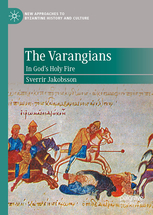
Professor Sverrir Jakobsson is interviewed in Morgunblaðið this week about his new book The Varangians: In God’s Holy Fire. He also talks about the Legends of the Eastern Vikings project and says that the Icelandic Sagas, including the Varangians, has been his main interest for the past 30 years, or more or less since he started university. Already in secondary school, Sverrir was known in Iceland for participating on his school team in the annual quiz show Gettu Betur alongside his twin brother Ármann, himself a now professor of Icelandic literature. The competition was broadcast on TV and needless to say, they won.
In the interview, Sverrir talks about the connections between the Icelandic Sagas and the Varangians. Among famous Saga personalities that served at the court of the Eastern Emperor are Kolskeggur (which translates as Blackbeard), who was the brother of the main hero Gunnar in Njáls’ Saga, and Bolli, one of the main protagonists of Laxdæla Saga, was a renowned Varangian too.
Interestingly, while the Byzantine Emperor’s Nordic troops are called “Varjagi” in Slavic chronicles, the term is not used in the oldest Icelandic sources from the 12th century, although veterans from Constantinople are mentioned. The moniker “Væringjar” first seems to come into use in the 13th century in Iceland, at a time when the Varangians, or at least their Nordic element, was in decline in Constantinople and the cohort was increasingly being constituted of Englishmen. The term “Varjagi” can be found in later Arabic sources, but comes later into the old Norse being used in Iceland at the time.
Morgunblaðið newspaper is of a rather later vintage but is Iceland’s oldest functioning newspaper and was founded in 1913. The full interview can be found (in modern Icelandic) on mbl.is.
“Áhugamál mitt í næstum þrjátíu ár.” Þriðjudagur, 19. janúar 2021.

